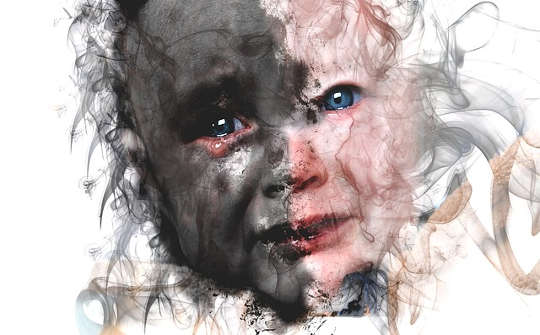
There are two kinds of suffering: The suffering that the world creates for us and the suffering we create ourselves. There’s no way around it; suffering is a fundamental part of being human. But you can choose to lessen the suffering and respond to it differently. To lessen suffering, we must change the mindset and actions that help create our problems. To respond differently is to accept the myriad of lessons that suffering provides. If you ignore your feelings and turn away from pain, you will only suffer more.
If we don’t grow from suffering, we die from it. Suffering can tether a person to the darker side of life so strongly that it makes passion and the enjoyment of life almost impossible. When you’re drowning in the depths of suffering, creativity and your Soul’s expression are the last things on your mind.
Suffering is not enjoyable, but it can be another great teacher on your path to healing. It will visit whether it’s invited or not. If you are willing to open the door when suffering arrives, you will benefit from its teachings. It can be a catalyst for greater intimacy, creativity, and art.
Suffering can bring people and nations together as well as open the heart for deeper compassion and service. To know the pain of suffering is to know the depth of your nature that otherwise would remain buried.
Be happy for this moment.
This moment is your life.
— Omar Khayyam
Processing the emotions of suffering allows you to increase trust in yourself and brings you closer to humanity. One can only understand the pain of others by enduring their own. This is not to say you should create unnecessary hardship or dwell in the sea of misery. But creating a new and positive relationship to suffering will help you heal.
Throughout your life, you’re subject to pain. But suffering becomes oppressive if you don’t learn to accept it and use its presence for spiritual evolution. Blocking negative experiences from our lives does not lead to happiness or good health, but instead it suffocates our spirits.
On the Run From Pain and Fear
For at least 10 years I was on the run. Not from the law, but from myself. I was running from my emotions, from pain, from fear. I have a curious spirit and love to explore, but the truth is those years were focused on trying to escape my suffering by creating a new reality.
I was hiding. I had experienced anxiety most of my life, the nail-biting nervous energy kind. It wasn’t until my mid-20s, after being assaulted and raped, that the anxiety had become an unwanted and yet constant companion.
To an outsider, my life looked pretty good. I was chasing my dreams. I wasn’t binging or purging and I was maintaining a relationship with my family. But deep inside I was in pain. I felt like I needed to hide so people wouldn’t see how scarred, damaged, and ugly I had become. I couldn’t move forward. I wasn’t happy and I was trapped in the confines of my sorrows.
Physical Symptoms Of Anxiety
You may be familiar with the physical symptoms of anxiety. Your veins rush cold, your bowels loosen, and the world spins. In those moments of panic, you seem to lose control of your life as you know it. Grief creates tightness in your chest and heaviness on your shoulders like a wet blanket of despair.
All organs, including your brain and heart, are connected to emotion and spirit. If one system is out of balance, it can throw the other systems out of balance, thus creating discomfort or disease.
There are numerous reasons that we get blocked and try to shut down our feelings, but suffering, particularly from guilt, is one of the most common.
For example, if you can’t accept and assimilate emotions, you may have trouble digesting food. Stopping the flow of feelings or denying your current reality in hopes of a better one causes more disconnection. Excess worry may cause headaches. Heartbreak can lead to angina. These are not trivial coincidences, but communicable reactions from emotion to body, mind to energy, Soul to Self.
Preparation Using Daily Practices Such As Mindfulness and Meditation
I believe every experience can either be a lesson or it can take you down. It’s your choice. When you find yourself in the center of the storm it’s difficult to make the correct emotional response. That’s why being prepared is crucial.
Preparation is achieved through daily practices such as mindfulness, meditation, and physical and Emotional Workouts. These techniques strengthen your core, your pillar, and lead you on the path to healing. You can experience radical self-love and freedom from constant suffering.
Becoming more centered and grounded provides the foundation that will allow you to go deeper within to meet your true nature. Fear of your feelings is a distraction from doing the work of the Soul.
I’m not afraid of storms for I’m learning to sail my ship.—Louisa May Alcott
Physical Imbalance
Every energetic imbalance of the mind, emotions, or spirit presents itself, in due time, as a physical imbalance. Fear keeps people disconnected from their feelings. We’re afraid of hurt, abandonment, love, suffering, and death. Afflictions to the spirit such as sexual, emotional, or verbal abuse also create blocks in this area.
Many factors can cause a person to go into protection mode. We subconsciously or consciously shut down our Feeling Center so we are not as susceptible to more negative emotions, but this can trigger physical and emotional ramifications. Physically we see results of blocked energy in the lower abdomen region.
Stagnant energy in the Sacral Chakra can present physical symptoms such as:
* Bloating
* Urinary or kidney problems
* Excess fat
* Lower abdomen protrusion
* Widening of the hips
* Sore lower back
* Fluid retention
* Tightness in the hips
* Problems with reproductive organs
* Fibroids
* Abnormal bowel function
* Adrenal fatigue
* Lymphatic issues
* Lack of libido
Imbalance of Emotional Symptoms
A weak or blocked Sacral Chakra may express an imbalance of emotional symptoms, which are indicated in the following list.
* Feeling detached
* Lack of libido
* Low self-esteem
* Lack of creativity
* Intimacy issues
* Jealousy
* Depression
* Codependency
* Sexual obsession
* Stuck in a mood or feeling
* Addiction to food or sex
* Fear
Although we all experience some of these symptoms at various times, it’s likely that repressed emotions are the cause of recurring symptoms. Attention is needed to free them. If you have on-going physical symptoms, please seek the advice of a physician.
Self-Induced Suffering Due to Guilt, Shame, and Manufactured Fear
Although suffering is often caused by outside influences, it may be surprising to learn that much of our suffering is self-induced by emotions like guilt, shame, and manufactured fear. The weight of guilt is like carrying a bowling ball tied around your waist.
Guilt is a common issue in our society. Guilt makes us believe we are wrong, but guilt never tells both sides of the story. Because we’re not taught how to express our true emotions in a healthy way, we tend to internalize and convert authentic feelings such as rage, anger, hurt, or sadness into self-blame, guilt, or shame. We are constantly monitoring our actions and feelings to ascertain our role and responsibility to life. We view the function and dysfunction of our experiences along with the reactions and responses from others.
Some people detach from guilt because they cannot handle the emotional weight and feelings that it brings, whether the guilt is warranted or not. This may occur with people who have personality disorders such as narcissism or people who experience a tremendous amount of emotional abuse as a child. In this case, a tremendous amount of energy is still expended on guilt, but on the avoidance or denial of it.
We’re taught as youngsters to withhold expressions of our true feelings. We may be told to keep our mouths shut or to sweep difficult feelings under a rug. These are unhealthy behaviors that pound down the hurt and pain, making the emotions hard and impacted deep within our bodies. Suffering then becomes denser and less accessible.
When emotions are pushed deep down and become hardened in our system, it’s helpful to work with an energy healer to break up the stagnant and compacted energy.
Emotional Workout
Cat-Cow: To free the Feeling Center, get on your hands and knees and make a table top with your back. Place your wrists under your shoulders, knees under your hips. On the inhale, bring your chin to the sky and raise your tailbone up, allowing your belly to dip toward the ground. On the exhale, lower your chin toward your chest as you round your back up, spine toward the ceiling, and tuck the tailbone between your legs. This will massage the spine and open the sacral energy. Repeat five to 10 times per session.
Many of us experience injuries to our spirits due to illness, environmental issues, lack of love, or grief. Emotional injuries can make you feel weak, but they can also be the catalyst to build your strength and character. It is right to allow your weakness as it can expand your love and acceptance. This is how you find strength.
Avoidance of weakness causes disconnection, which moves us away from our Soul and toward self-inflicted harm, or at the very least, we find ourselves off track from our authentic path.
Emotional Workout
An Exercise on Suffering: Take a piece of blank white paper. Close your eyes and take three deep calming breaths. Open your eyes and write one to two words that capture the essence of your suffering. It may be a name, a disease, an addiction, or a long-harbored feeling of guilt. Don’t over-think, just write the first words that come to your mind.
Close your eyes again and envision the word(s) on the page. See the word on the white piece of paper, allowing the word and its feeling to flow into your body with each breath. Repeat the word like a mantra. By doing this, we access and allow the reality of the suffering to re-integrate and become part of our core pillar of strength. This may feel uncomfortable at first, but remain present with it for at least three breaths.
Open your eyes and the turn the paper over. Write a word or two that describes the healing antidote to your suffering. It could be love, forgiveness, a name, an apology, or a feeling such as joy or peace. What is the emotion that is opposite to your suffering?
Close your eyes and take three deep breaths and relax. As you inhale, imagine breathing in this word of healing. Use it as a mantra as you breathe. Inhale the emotion into your being. If you wish, lift the sides of your lips and create a little smile during the process.
Healing happens as we become more present. With our presence, we lose resistance. The less we resist, the less it persists.
Suffering and Healing Exist on the Same Dimension But With A Different Perspective
As on the paper, the experiences of both suffering and healing exist on the same dimension but from a different perspective. You don’t have to sit and only breathe in the suffering, you can go to the other side and breathe in healing. You have the capacity for both.
There will always be an equal amount of healing available to mitigate the suffering if you give it the same focus. To discard the suffering, you will also discard the healing antidote as it is attached to the other side of your experience. Healing requires us to suffer.
You may think, “If I don’t suffer I won’t need to heal.” But you can’t awaken if there’s nothing to awaken from. It’s the science of polarity. Yin and Yang. Good and evil. It’s the experience of humanity. Radical self-love awakens as we embrace this reality and integrate the experiences of our suffering so we can transform them into our healing.
©2017 by Leah Guy. All Rights Reserved.
Published by New Page Books,
a division of Career Press. 800-227-3371.
Article Source
The Fearless Path: A Radical Awakening to Emotional Healing and Inner Peace
by Leah Guy.
 In The Fearless Path, you will learn: * Why “letting go” is the worst advice for healing, and how to really move on. * How to understand the stories your energy system tells about your mind, body, and spirit ? and how to rewrite the script. * How to transform fear and anxiety into love and inner peace. * Why the law of attraction isn’t all it’s cracked up to be. * Find strength and serenity in the midst of a personal storm.
In The Fearless Path, you will learn: * Why “letting go” is the worst advice for healing, and how to really move on. * How to understand the stories your energy system tells about your mind, body, and spirit ? and how to rewrite the script. * How to transform fear and anxiety into love and inner peace. * Why the law of attraction isn’t all it’s cracked up to be. * Find strength and serenity in the midst of a personal storm.
Click here for more info and/or to order this book.
About the Author
 Leah Guy is an intuitive transpersonal healer, spiritual teacher, professional speaker, and media personality. She has developed a framework to help people transform trauma and pain into peace and wholeness. She is a sought-after inspirational speaker who has appeared on major media outlets as an experts on topics such as meditation, the mind-body connection, energy-medicine and chakra balancing, intuition and addiction as well as emotional and spiritual healing. Known as The Modern Sage, she is the owner of two companies, Modern Sage, LLC and A Girl Named Guy Productions, LLC, a lifestyle media company. For more information, please visit her at www.LeahGuy.com.
Leah Guy is an intuitive transpersonal healer, spiritual teacher, professional speaker, and media personality. She has developed a framework to help people transform trauma and pain into peace and wholeness. She is a sought-after inspirational speaker who has appeared on major media outlets as an experts on topics such as meditation, the mind-body connection, energy-medicine and chakra balancing, intuition and addiction as well as emotional and spiritual healing. Known as The Modern Sage, she is the owner of two companies, Modern Sage, LLC and A Girl Named Guy Productions, LLC, a lifestyle media company. For more information, please visit her at www.LeahGuy.com.


























